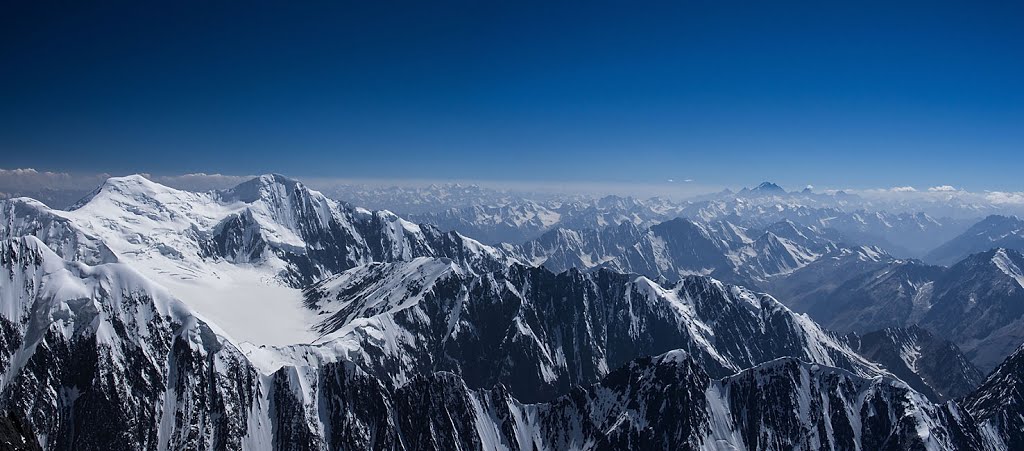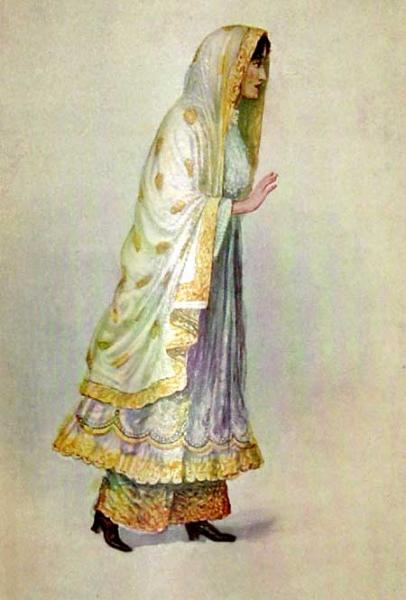|
Fayzabad, Badakhshan
Fayzabad (also spelled Feyzabad or Faizabad) ( fa, فيض آباد, Fayzâbâd) is a city in northeastern Afghanistan, with a population of around 39,555 people. It serves as the provincial capital and largest city of Badakhshan Province. It is situated in Fayzabad District and is at an altitude of . Fayzabad is the main commercial and administrative center of the Pamir region. The Kokcha River runs alongside the city. The Fayzabad Airport is located next to the city, which provides limited domestic flight services. History The city was called Jauz Gun until 1680 because of the many walnut ("jauz") farms in the area. The name was changed to Faizabad, which can be roughly translated as "abode of divine bounty, blessing, and charity", when the robe of Prophet Muhammed was delivered to the city. Tradition states that it was brought here by Muhammad Shaykh Ziya and Shaykh Niyaz after Wais Quran brought it to Balkh. At that time the city replaced Munjan as the capital of Badak ... [...More Info...] [...Related Items...] OR: [Wikipedia] [Google] [Baidu] |
Kokcha River
The Kokcha River ( fa, رودخانه کوکچه) is located in northeastern Afghanistan. A tributary of the Panj river, it flows through Badakhshan Province in the Hindu Kush. It is named after the Koksha Valley. The city of Feyzabad lies along the Kokcha. Near the village of Artin Jelow there is a bridge over the river. Course The Kokcha begins in Kuran wa Munjan District near the district center of Kuran wa Munjan and flows north, passing through Yamgan District and Jurm District. Near the village of Baharak, the Warduj river meets the Kokcha. The river then flows east, going around the northern border of Argo District and passing Feyzabad. Finally, the Kokcha enters Takhar Province, flows around the southern border of Rustaq District, and ends at the Amu Darya by Ai-Khanoum. See also * List of rivers of Afghanistan This is a list of rivers wholly or partly in Afghanistan, arranged geographically by river basin. Flowing into the Arabian Sea *''Indus River (Pakis ... [...More Info...] [...Related Items...] OR: [Wikipedia] [Google] [Baidu] |
Samarkand
fa, سمرقند , native_name_lang = , settlement_type = City , image_skyline = , image_caption = Clockwise from the top: Registan square, Shah-i-Zinda necropolis, Bibi-Khanym Mosque, view inside Shah-i-Zinda, Sher-Dor Madrasah in Registan, Timur's Mausoleum Gur-e-Amir. , image_alt = , image_flag = , flag_alt = , image_seal = Emblem of Samarkand.svg , seal_alt = , image_shield = , shield_alt = , etymology = , nickname = , motto = , image_map = , map_alt = , map_caption = , pushpin_map = Uzbekistan#West Asia#Asia , pushpin_map_alt = , pushpin_mapsize = 300 , pushpin_map_caption = Location in Uzbekistan , pushpin_label_position = , pushpin_relief = 1 , coordinates = , coor_pinpoint = ... [...More Info...] [...Related Items...] OR: [Wikipedia] [Google] [Baidu] |
Graz, Austria
Graz (; sl, Gradec) is the capital city of the Austrian state of Styria and second-largest city in Austria after Vienna. As of 1 January 2021, it had a population of 331,562 (294,236 of whom had principal-residence status). In 2018, the population of the Graz larger urban zone (LUZ) stood at 652,654, based on principal-residence status. Graz is known as a college and university city, with four colleges and four universities. Combined, the city is home to more than 60,000 students. Its historic centre (''Altstadt'') is one of the best-preserved city centres in Central Europe. In 1999, the city's historic centre was added to the UNESCO list of World Heritage Sites and in 2010 the designation was expanded to include Eggenberg Palace (german: Schloss Eggenberg) on the western edge of the city. Graz was designated the Cultural Capital of Europe in 2003 and became a City of Culinary Delights in 2008. Etymology The name of the city, Graz, formerly spelled Gratz, most likely stems f ... [...More Info...] [...Related Items...] OR: [Wikipedia] [Google] [Baidu] |
2021 Taliban Offensive
A military offensive by the Taliban insurgent group and other allied militants led to the fall of the Islamic Republic of Afghanistan based in Kabul and marked the end of the nearly 20-year-old War in Afghanistan, that had begun following the United States invasion of the country. The Taliban victory had widespread domestic and international ramifications regarding human rights and proliferation of terrorism. The offensive included a continuation of the bottom-up succession of negotiated or paid surrenders to the Taliban from the village level upwards that started following the February 2020 US–Taliban deal. The offensive began on 1 May 2021, coinciding with the withdrawal of the United States's 2,500 troops in Afghanistan, and those belonging to other international allies. Large numbers of armed civilians, including women, volunteered with the Afghan Army in defense, while some former warlords notably Ismail Khan were also recruited. Despite this, the Taliban managed to ... [...More Info...] [...Related Items...] OR: [Wikipedia] [Google] [Baidu] |
Czech Republic
The Czech Republic, or simply Czechia, is a landlocked country in Central Europe. Historically known as Bohemia, it is bordered by Austria to the south, Germany to the west, Poland to the northeast, and Slovakia to the southeast. The Czech Republic has a hilly landscape that covers an area of with a mostly temperate continental and oceanic climate. The capital and largest city is Prague; other major cities and urban areas include Brno, Ostrava, Plzeň and Liberec. The Duchy of Bohemia was founded in the late 9th century under Great Moravia. It was formally recognized as an Imperial State of the Holy Roman Empire in 1002 and became a kingdom in 1198. Following the Battle of Mohács in 1526, the whole Crown of Bohemia was gradually integrated into the Habsburg monarchy. The Protestant Bohemian Revolt led to the Thirty Years' War. After the Battle of White Mountain, the Habsburgs consolidated their rule. With the dissolution of the Holy Empire in 1806, the C ... [...More Info...] [...Related Items...] OR: [Wikipedia] [Google] [Baidu] |
Denmark
) , song = ( en, "King Christian stood by the lofty mast") , song_type = National and royal anthem , image_map = EU-Denmark.svg , map_caption = , subdivision_type = Sovereign state , subdivision_name = Kingdom of Denmark , established_title = Consolidation , established_date = 8th century , established_title2 = Christianization , established_date2 = 965 , established_title3 = , established_date3 = 5 June 1849 , established_title4 = Faroese home rule , established_date4 = 24 March 1948 , established_title5 = EEC accession , established_date5 = 1 January 1973 , established_title6 = Greenlandic home rule , established_date6 = 1 May 1979 , official_languages = Danish , languages_type = Regional languages , languages_sub = yes , languages = GermanGerman is recognised as a protected minority language in the South Jutland area of Denmark. , demonym = , capital = Copenhagen , largest_city = capital , coordinates = , ethnic_groups = , ethnic_gro ... [...More Info...] [...Related Items...] OR: [Wikipedia] [Google] [Baidu] |
Provincial Reconstruction Team
A Provincial Reconstruction Team (PRT) was a unit introduced by the United States government, consisting of military officers, diplomats, and reconstruction subject matter experts, working to support reconstruction efforts in unstable states. PRTs were first established in Afghanistan in early 2002, and were used in Iraq as well. While the concepts are similar, PRTs in Afghanistan and Iraq had separate compositions and missions. Their common purpose, however, was to empower local governments to govern their constituents more effectively. Structure A PRT included a military component ( Civil Affairs/Force Protection, etc.), civilian police advisors, and civilian representatives of US (or other national) government foreign affairs agencies. In a US-led PRT, this generally included a representative from USAID, the Department of State, the Department of Agriculture, and the Department of Justice. They were assisted by public diplomacy and reporting staff. The PRTs were the primary ... [...More Info...] [...Related Items...] OR: [Wikipedia] [Google] [Baidu] |
Germany
Germany, officially the Federal Republic of Germany (FRG),, is a country in Central Europe. It is the most populous member state of the European Union. Germany lies between the Baltic and North Sea to the north and the Alps to the south. Its 16 constituent states have a total population of over 84 million in an area of . It borders Denmark to the north, Poland and Czechia to the east, Austria and Switzerland to the south, and France, Luxembourg, Belgium, and the Netherlands to the west. The nation's capital and most populous city is Berlin and its main financial centre is Frankfurt; the largest urban area is the Ruhr. Settlement in what is now Germany began in the Lower Paleolithic, with various tribes inhabiting it from the Neolithic onward, chiefly the Celts. Various Germanic tribes have inhabited the northern parts of modern Germany since classical antiquity. A region named Germania was documented before AD 100. In 962, the Kingdom of Germany formed the ... [...More Info...] [...Related Items...] OR: [Wikipedia] [Google] [Baidu] |
Badakhshan Province
Badakhshan Province ( Persian/ Uzbek: , ''Badaxšān'') is one of the 34 provinces of Afghanistan, located in the northeastern part of the country. It is bordered by Tajikistan's Gorno-Badakhshan in the north and the Pakistani regions of Lower and Upper Chitral and Gilgit-Baltistan in the southeast. It also has a 91-kilometer (57-mile) border with China in the east. It is part of a broader historical Badakhshan region, parts of which now also lie in Tajikistan and China. The province contains 22 districts, over 1,200 villages and approximately 1 055 00people. Fayzabad, Badakhshan, Fayzabad serves as the provincial capital. Resistance activity has been reported in the province since the 2021 Taliban takeover of Afghanistan. Etymology Badakhshan's name comes from the Middle Persian word "badaxš", which is an official title. The word "ān" is a suffix which demonstrates a place's name; therefore the word "badaxšān" means a place belonging to a person called "badaxš". ... [...More Info...] [...Related Items...] OR: [Wikipedia] [Google] [Baidu] |
Soviet Union
The Soviet Union,. officially the Union of Soviet Socialist Republics. (USSR),. was a List of former transcontinental countries#Since 1700, transcontinental country that spanned much of Eurasia from 1922 to 1991. A flagship communist state, it was nominally a Federation, federal union of Republics of the Soviet Union, fifteen national republics; in practice, both Government of the Soviet Union, its government and Economy of the Soviet Union, its economy were highly Soviet-type economic planning, centralized until its final years. It was a one-party state governed by the Communist Party of the Soviet Union, with the city of Moscow serving as its capital as well as that of its largest and most populous republic: the Russian Soviet Federative Socialist Republic, Russian SFSR. Other major cities included Saint Petersburg, Leningrad (Russian SFSR), Kyiv, Kiev (Ukrainian Soviet Socialist Republic, Ukrainian SSR), Minsk (Byelorussian Soviet Socialist Republic, Byelorussian SSR), Tas ... [...More Info...] [...Related Items...] OR: [Wikipedia] [Google] [Baidu] |
Khoja
The Khojas ( sd}; gu, ખોજા, hi, ख़ोजा) are a mainly Nizari Isma'ili Shia community of people originating in Gujarat, India. Derived from the Persian Khwaja, a term of honor, the word Khoja is used to refer to Lohana Rajputs or Baniya castes who converted to Islam from Hinduism. They are historically members of the Bania groups converted to Islam by Muslim pirs (saints). In India, most Khojas live in the states of Gujarat, Maharashtra, Rajasthan and the city of Hyderabad. Many Khojas have also migrated and settled over the centuries in East Africa, the Caribbean, Europe and North America. The Khoja were by then adherents of Nizari Isma'ilism. In the late 19th and early 20th centuries, particularly in the aftermath of the Aga Khan Case a significant minority separated and adopted Sunni Islam and Twelver shi'ism, while the majority remained Nizari Isma'ili. In Pakistan, most Khoja live in Karachi in Sindh province. Etymology The term ''Khoja'' derives ... [...More Info...] [...Related Items...] OR: [Wikipedia] [Google] [Baidu] |






